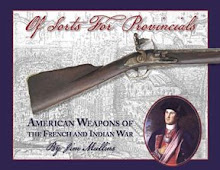Choosing a gun for a Revolutionary War militia impression.
One of the more costly (and thus difficult) choices to make when equipping for a Revolutionary war militia (or early war Continental soldier) impression is firearm choice. Like many modern conflicts, the early battles of the Revolutionary war were frequently fought with the leftovers from the last war; the French and Indian or Seven Years war.
“The Companies that
served upon the Ohio last year having been disbanded by Act of
Assembly Upon their return into this Province and a Gratuity of £5
having been allowed to all such as should return into the province
and as the most part of them upon their return through Virginia
dispersed and carried off their Arms, and a very small number
returned to receive that Gratuity-” Arthur Dobbs to the Speaker
and the Gentlemen of the Assembly 17 May 1759 (Colonial Records of
North Carolina)
In choosing a plausible firelock for this impression, it is a good idea to nail down what actually existed and was common in the area being represented. Sadly, great lists like this one from Hyde County NC are rare items (those types are further illustrated here), but it does a great job of showing the diversity in arms that some militia companies fielded.
The MACARONI SPORTSMAN. by M. Darly 1772 (Lewis Walpole Library).
Fowling Pieces:
Likely the most common civilian arm of the era, there are contexts
where English import
fowling pieces are an acceptable choice for a militia impression. The new
fowling gun kits from Jim Kibler appear to be a great option for that route. in some areas, regional restock styles (New England, Hudson valley) are also a solid choice. Four foot barrels and walnut stocks appear to have been the most popular.
Muskets:
Luckily, three main front runners have been identified for "common" muskets from the prior conflict that were imported for provincial use and were very widespread in the colonies. This list is in no way all inclusive, many other varieties can be documented in almost every colony (for instance, small amounts of captured Spanish muskets in Massachusetts and Pennsylvania, as well as local restocks and etc), but these three main options offer "safe" choices via documented usage in large numbers in the colonies below (the majority of them are found through primary documents but some via excavated parts).
Muskets of the King's pattern:
Pattern 1742 muskets with wooden rammers were the workhorses of the French and Indian War, half of all imported
muskets from the Tower were of this type (well over 10,000 stands). In addition, some earlier guns (Pattern 1730s in Georgia and Queen Anne era muskets in multiple colonies) can be documented in some places. The best reproduction option that is currently available is from the Rifle Shoppe or parts from Track of the Wolf, although some have had decent success reworking Pedersoli short land muskets towards the general look of a pattern 42- a conversion I believe was pioneered by the late
Kit Ravenshear. However, the barrel will be 4 inches too short. As an aside, before buying or building anything I recommend you do yourself a favor and compare any reproduction muskets with the illustrations in Goldstein and Mowbray's
The Brown Bess; An Identification Guide and Illustrated Study of Britain's Most Famous Musket.
Dutch Muskets:
Dutch Muskets were the second most commonly imported guns from Ordnance stores during the F&I era for use here. The best reproduction option that is currently available is from the Rifle Shoppe (Dutch type II series 693 without barrel bands and wooden rammer).
Wilson commercial military style muskets:
Wilson commercial military style
muskets saw wide spread use in various configurations, generally following the lines of King's Pattern guns with lighter and cheaper furniture. The best reproduction option that is currently available for these is from the Rifle Shoppe (Series 671), although some have had success reworking Pedersoli short land muskets (furniture swap, remarking), they will be about 4 inches too short in the barrel for most of the earlier applications (a surviving New York Wilson musket has been shortened to 42 inches and there are surviving military style
fusees and muskets that appear to have been that length from the start).







